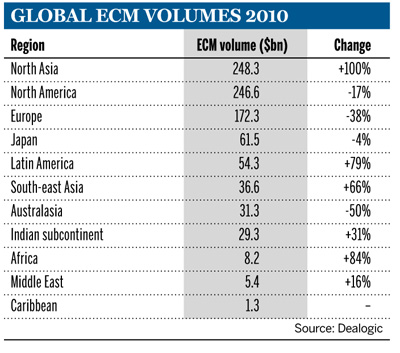Will risk on, risk off continue into 2011?
The equity markets have experienced a year of volatility, with significant increases in volume in emerging markets and declines in developed regions. However, participants expect some return to normality and stability in 2011.
Following the successful sale of Portuguese, Spanish and Italian government bonds on January 12, stock markets rallied significantly, as fears over the eurozone sovereign crisis eased. The FTSE All-World equity index hit its highest point since August 2008, the Standard & Poor's S&P 500 rose to its best level since September 2008, while South Korea's Kospi index briefly hit an all-time high.
Editor's choice
These moves said much about the fate of equity capital markets (ECM) last year, and clearly speak to the tone in the early part of 2011. In 2010, the 'risk on, risk off' (RoRo) market sentiment – driven by other markets and uncertainty around peripheral eurozone sovereigns – offset many of the improving signals coming out of companies and the broader global economy.
A recent paper from HSBC's quantitative strategy team echoes this. It highlighted findings from an index the bank has compiled of the RoRo effect. It revealed that today's equity valuations are more a product of larger external forces than of their own fundamentals. It also showed that correlation between apparently unrelated assets is at levels not seen in the 20 years that HSBC has been able to calculate it, leading the report to suggest there has been a structural shift that may last for years.
In any event, RoRo led to an unpredictable year for equities in 2010. Global ECM volume was down 1% year on year, but the fourth quarter had the highest volume of transactions on record – an increase of 74% on the third quarter. Global initial public offering (IPO) volumes reached $280.2bn, the second highest annual volume on record after 2007 – again driven by an extraordinary fourth quarter, up 133% on the third quarter.
Emerging markets up
The tectonic shift between developed and emerging markets continued. Emerging market ECM volumes reached $406.3bn, up 87% on 2009. This was the highest volume on record for those regions and represented 45% of global ECM in 2010, compared with 24% the year before. In the IPO market, Asia-Pacific accounted for 66% of the global volume in 2010, with eight of the 10 largest IPOs of the year coming from that region.
"The reasons Asia-Pacific dominated IPO numbers – and emerging markets commanded a high proportion of broader ECM volumes – are both secular and cyclical," says John Crompton, HSBC's global head of ECM. "In Asia it was a bit of both. [The region] is enjoying buoyant secular growth and has not been hit so hard by cyclical downturn."
US and EMEA decline
Volumes in the US and in Europe, the Middle East and Africa (EMEA), by contrast, suffered declines of 17% and 38%, respectively.
"The decline in EMEA volumes was pretty drastic," says Emmanuel Gueroult, co-head of EMEA ECM at Morgan Stanley. "By and large, the financial institutions group recapitalisations that helped to drive the markets in 2009 were not there in 2010, and were not entirely replaced by the reopening of the IPO market and the upsurge in emerging market activity. But, while the high expectations for 2010 were not met, we think activity in 2011 could pick up by at least 15% to 20% in what we hope should be a less volatile environment."
Everyone agrees that emerging markets will continue to be an important component of market volumes, but few believe that emerging markets – specifically Asia-Pacific in IPOs – will dominate market activity to the same degree in 2011.
"Asia, and emerging markets in general, will continue to be very busy, although they're unlikely to represent the same high proportion of overall activity that we saw in 2010," says Matthew Westerman, global head of ECM at Goldman Sachs.
"We expect the US to be much busier and, pending conditions in individual markets, there is likely to be a pick-up in activity across Europe."
Consensus on trends
There is general consensus on the broad global themes that will drive ECM, and on which sectors will see the most activity. Preparation for the Basel III banking reforms and the drive to pay back government investors or to offset slower earnings will probably drive financial institution issuance (with 12 to 15 likely candidates having to raise capital); the EU's planned Solvency II insurance regulations and potential mergers and acquisitions (M&A) should lead to more issuance in the insurance sector.
Governments keen to deleverage will bring privatisation-led IPOs, block deals and exchangeables. A pick-up in M&A – and a greater preference for more conservative capital structures – should underpin increased equity financing. And the continued rise in commodity demand should see healthy volumes from natural resources companies.
In general, market participants are positive about the prospects for greater ECM activity across the board in 2011 – albeit with a few caveats, particularly concerning Europe.
"There are still some headline risks – especially surrounding peripheral Europe," says Nick Williams, head of EMEA ECM at Credit Suisse. "But there are a lot of positive themes [for Europe] too, including continued and improving corporate performance, more corporate investment and support from emerging market consumers. Together, these and other trends should provide a catalyst for growing equity market activity."



